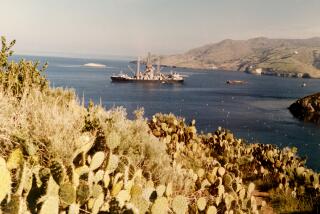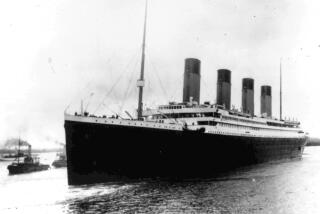Sunken Sub a Lure to Secret Data Sleuths
- Share via
Within hours of learning that a Soviet nuclear-powered submarine had gone down Friday near the Arctic Circle, naval analysts and intelligence sources began talk of retrieving what could be a treasure trove of top-secret data from the sunken vessel.
For decades, the lure of treasure--whether it be gold bullion or an intelligence gold mine--has prompted scores of efforts to raise sunken ships.
The value of the “finds” has made advances in recovery technology all the more crucial.
In 1974, the controversial derrick-and-claw-equipped Glomar Explorer, which was designed specifically for deep-sea retrieval, was dispatched to an ocean area off Hawaii to carry out a mission for the CIA called “Project Jennifer.” It is believed to have snatched from three miles deep on the ocean floor perhaps one-third of a Soviet nuclear-armed submarine that sank in 1968.
Technological Advances
Twelve years later, when the U.S. Navy sent ships and divers to recover fragments of the space shuttle Challenger off the Florida coast, the technology had advanced tenfold.
The state of the art, in fact, has allowed explorers to use manned and unmanned “submersibles,” like “Jason Jr.,” the photo reconnaissance system employed in the exploration of the ocean liner Titanic in 1986. “Jason Jr.,” which is directed by a joy stick from a manned submersible called the Alvin, roamed the Titanic and sent back photo images of the wreck.
More sophisticated and maneuverable versions, including Deep Drone and Recon IV, are equipped with “manipulators” so they can not only photograph but retrieve samples. The Recon IV is already used to inspect underwater oil pipelines and offshore drilling rigs.
The one-ton Deep Drone, which was sent down in 1986 to size up the sunken Civil War ironclad warship Monitor before the actual salvage effort got under way, is also capable of measuring electrical currents created by metal and seawater, which tell researchers what areas of a hull are weakest from having rusted out.
More Versatile System
Buoyed by their success in exploring the Titanic, the Woods Hole Oceanographic Institution in Massachusetts has been working on a larger and more versatile system, dubbed the Argo/Jason, which is designed to dive 5,000 feet deeper than Alvin and carries an unmanned robot that could bring back pieces of the sunken wreckage.
Although the Glomar Explorer is the best-known intelligence salvage operation, it may not be the only one. According to the New York Times, the Soviet November-class torpedo-attack submarine that sank off the Iberian coast in 1970 was inspected by the United States using undersea devices, and in 1971 the United States reportedly salvaged electronic eavesdropping equipment from a sunken Soviet trawler and gathered a nuclear weapon and electronic equipment from undersea wreckage of two Soviet planes.
There has also been some success with raising sunken ships. One involved the Mary Rose, Henry VIII’s Tudor flagship that sank in July, 1545, and was brought up in 1982 with the use of a special cradle. Another was the Civil War-era Monitor, which sank in 220 feet of water off Cape Hatteras in the Atlantic Ocean. Its coral-encrusted anchor was retrieved by using a flotation bag.
More to Read
Sign up for Essential California
The most important California stories and recommendations in your inbox every morning.
You may occasionally receive promotional content from the Los Angeles Times.













